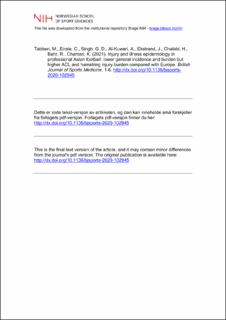| dc.contributor.author | Tabben, Montassar | |
| dc.contributor.author | Eirale, Cristiano | |
| dc.contributor.author | Singh, Gurcharan Dato | |
| dc.contributor.author | Al-Kuwari, Abdulaziz | |
| dc.contributor.author | Ekstrand, Jan | |
| dc.contributor.author | Chalabi, Hakim | |
| dc.contributor.author | Bahr, Roald | |
| dc.contributor.author | Chamari, Karim | |
| dc.date.accessioned | 2021-04-28T09:13:33Z | |
| dc.date.available | 2021-04-28T09:13:33Z | |
| dc.date.created | 2021-03-18T09:57:41Z | |
| dc.date.issued | 2021 | |
| dc.identifier.citation | British Journal of Sports Medicine. 2021, 1-6. | en_US |
| dc.identifier.issn | 0306-3674 | |
| dc.identifier.uri | https://hdl.handle.net/11250/2740099 | |
| dc.description | I Brage finner du siste tekst-versjon av artikkelen, og den kan inneholde ubetydelige forskjeller fra forlagets pdf-versjon. Forlagets pdf-versjon finner du på bjsm.bmj.com / In Brage you'll find the final text version of the article, and it may contain insignificant differences from the journal's pdf version. The original publication is available at bjsm.bmj.com | en_US |
| dc.description.abstract | Background: While football injury and illness epidemiology surveillance at professional club level in Europe is available, epidemiological data from other continents are lacking. Purpose: Investigating injury and illness epidemiology in professional Asian football. Study design: Descriptive prospective study. Methods: Professional teams from the Asian Football Confederation (AFC) league were followed prospectively for three consecutive AFC seasons (2017 through 2019, 13 teams per season, 322 team months). Time-loss injuries and illnesses in addition to individual match and training exposure were recorded using standardised digital tools in accordance with international consensus procedures. Results: In total, 232 665 hours of exposure (88.6% training and 11.4% matches) and 1159 injuries were recorded; 496 (42.8%) occurred during matches, 610 (52.6%) during training; 32 (2.8%) were reported as ‘not applicable’ and for 21 injuries (1.8%) information was missing. Injury incidence was significantly greater during match play (19.2±8.6 injuries per 1000 hours) than training (2.8±1.4, p<0.0001), resulting in a low overall incidence of 5.1±2.2. The injury burden for match injuries was greater than from training injuries (456±336 days per 1000 hours vs 54±34 days, p<0.0001). The two specific injuries causing the greatest burden were complete ACL ruptures (0.14 injuries (95% CI 0.9 to 0.19) and 29.8 days lost (29.1 to 30.5) per 1000 hours) and hamstring strains (0.86 injuries (0.74 to 0.99) and 17.5 days (17.0 to 18.1) lost per 1000 hours). Reinjuries constituted 9.9% of all injuries. Index injuries caused 22.6±40.8 days of absence compared with 25.1±39 for reinjuries (p=0.62). The 175 illnesses recorded resulted in 1.4±2.9 days of time loss per team per month. Conclusion: Professional Asian football is characterised by an overall injury incidence similar to that reported from Europe, but with a high rate of ACL ruptures and hamstring injury, warranting further investigations. | en_US |
| dc.language.iso | eng | en_US |
| dc.subject | epidemiology | en_US |
| dc.subject | injury mechanism | en_US |
| dc.subject | longitudinal study | en_US |
| dc.subject | soccer | en_US |
| dc.title | Injury and illness epidemiology in professional Asian football: lower general incidence and burden but higher ACL and hamstring injury burden compared with Europe | en_US |
| dc.type | Peer reviewed | en_US |
| dc.type | Journal article | en_US |
| dc.description.version | acceptedVersion | en_US |
| dc.source.pagenumber | 6 | en_US |
| dc.source.journal | British Journal of Sports Medicine | en_US |
| dc.identifier.doi | 10.1136/bjsports-2020-102945 | |
| dc.identifier.cristin | 1898908 | |
| dc.description.localcode | Institutt for idrettsmedisinske fag / Department of Sports Medicine | en_US |
| cristin.ispublished | true | |
| cristin.fulltext | postprint | |
| cristin.qualitycode | 2 | |
